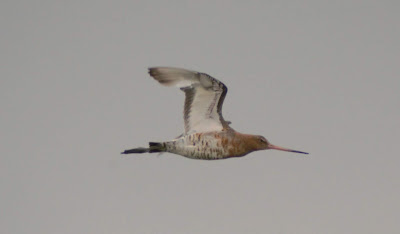Hey Yossarian - how d'ya know these are islandica?
"Because they're moulting"
Yeah - but how d'ya know they're moulting?
"Because they're islandica"
The problem with godwits is that they don't seem to be playing by the rules. The books say that limosa Black'wits start their moult in June, some even in late May, and by the middle of July, most are wearing their winter grey plumage. The books also say that islandica don't start their moult until August.
The trouble is, that on the first day of August, I went up to the coast to see what was happening with the godwits there. I wanted to see godwits away from the breeding grounds of the washes, with the expectation that any birds at Titchwell would be freshly arrived islandica, rather than the mix of limosa and islandica that had been mooching in front of the main hide at Welney in July.
Studying the birds at Welney had been somewhat frustrating. I knew what I thought I was watching, but other than having a few thoughts confirmed thanks to the ringing scheme giving solid information of the provenance of some birds, it had become obvious that there was an uncomfortable zone of fuzziness that made identification of race very difficult.
All the birding ID papers I'd read have emphasised this problem - but what I couldn't figure out was why this problem should exist, when the more scientific literature painted a different picture. "Birds of the Western Palearctic" is supported by the BTO's own "Identification of European Non-Passerines", and both publications seem pretty emphatic - if an adult Black-Tailed Godwit is still in summer plumage at the beginning of August, it must be an islandica.
like this one..
Structurally, this bird fits the bill - the shortish bill typical of islandica. Its head is squarish, and lacks the sloping crown that limosa is noted for. There's a fair amount of orange and black feathering - about 50% of the scapulars, which is perhaps on the lowish end of the scale for islandica, but way at the extreme highest end for limosa. So things are starting to get fuzzy. The pattern of the summer feathers points to islandica - but there is a bit of moult going on....
And what about this bird nearby?
Almost identical in structure and size - but the moult of this bird is far more advanced. That can't be right though? The books clearly say - fine then, what about the wings. It's all very well to have a few scaps or coverts changed, but the wings definitely don't start moulting until August when the Icelandic birds have reached their wintering grounds. If these birds are islandica, on the first day of August, they should have unmoulted wings.
Ok, Ok, so there's one bird out of a flock of fifty or more with a couple of dropped inner primaries. It's fine... they don't know exactly when the 1st August is - it's not surprising to find the odd bird that started a few days early.
Or three birds that started a few days early.....
It's not like they've started growing new feathers- they've just dropped a few old ones. Haven't they?
Oh.
Apparently not. This last picture shows the true range of moult within the flock. The lowest bird has dropped a few inners, but not replaced them. The highest bird has dropped- and replaced 7. They're not fully grown yet, but the second lowest bird has almost completed a full moult. Just the outer primary is old, and all the rest are very nearly completely grown. It's difficult to see, but this bird has also lost most of its summer bars and orange.
So what's going on? Are the books wrong? Is this a peculiar year where all the islandica have moulted early? When the literature says islandica moult from August to December. do they really mean...mostly
I've got a bad feeling about this.















